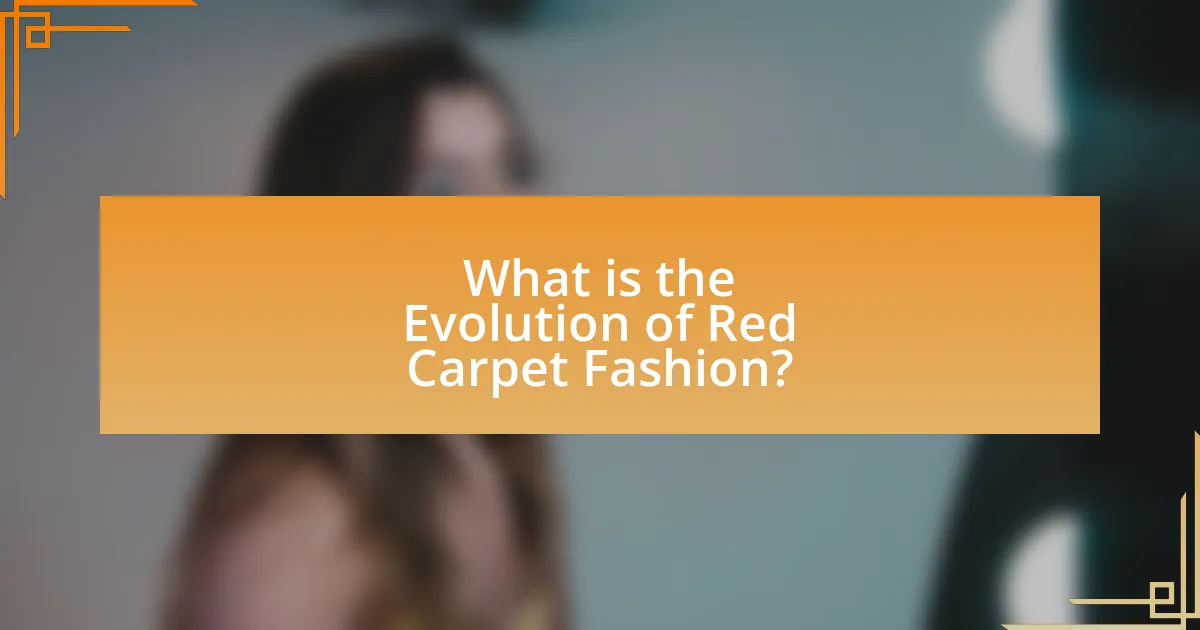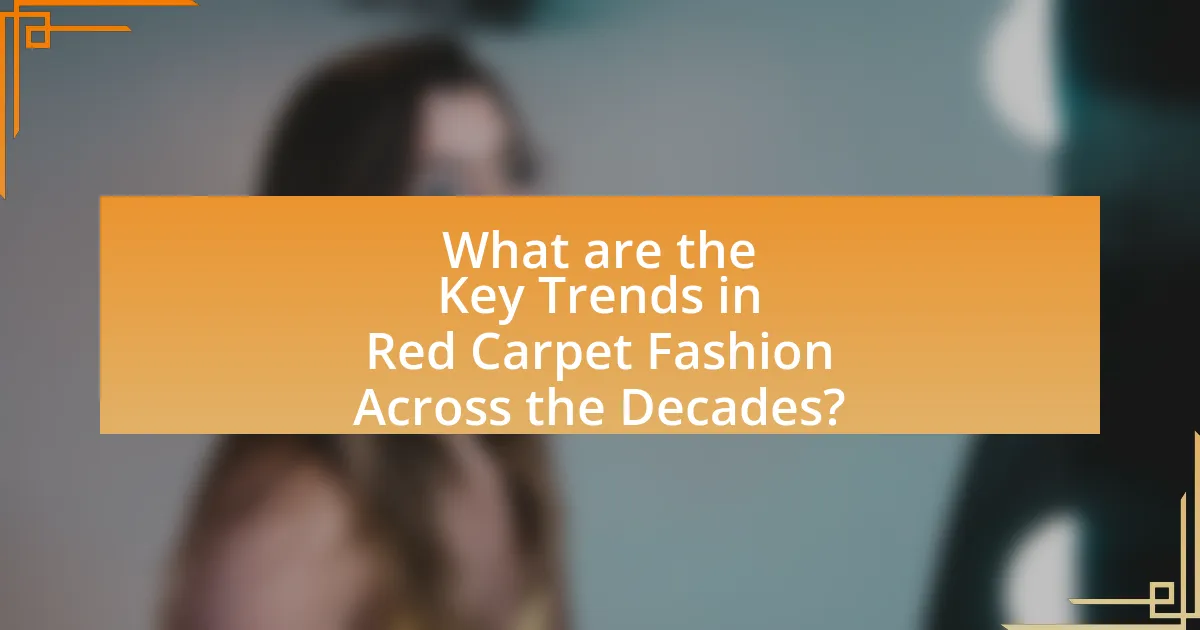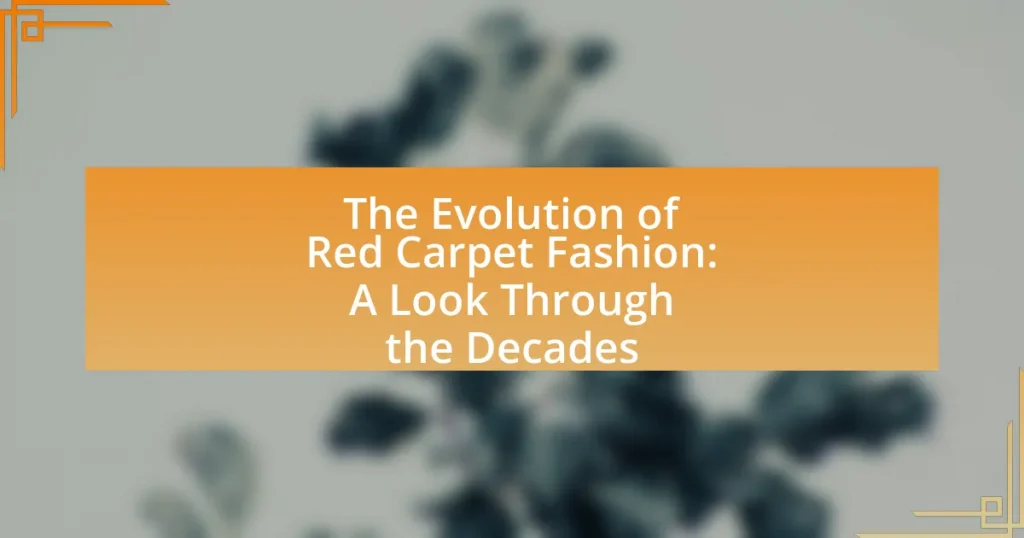The article examines the evolution of red carpet fashion, highlighting its transformation over the decades in response to societal norms, celebrity influence, and fashion trends. It begins with the formal styles of the early 20th century, progresses through the daring looks of the 1960s and 1970s, and explores the rise of designer labels in the 1980s and the blend of glamour and casual styles in the 1990s and early 2000s. The discussion includes the impact of social movements on fashion choices, the significance of red carpet appearances in shaping public perception, and the current focus on sustainability and inclusivity in fashion. Key trends and memorable moments from the last decade are also highlighted, along with practical tips for celebrities to enhance their red carpet presence.

What is the Evolution of Red Carpet Fashion?
The evolution of red carpet fashion reflects changing societal norms, celebrity influence, and fashion trends over the decades. Initially, in the early 20th century, red carpet events were formal occasions where attendees wore elegant gowns and tuxedos, exemplified by the Academy Awards’ inception in 1929. As the decades progressed, the 1960s and 1970s introduced more daring styles, with celebrities like Elizabeth Taylor and Cher pushing boundaries with bold colors and unique silhouettes. The 1980s saw the rise of designer labels, with stars like Princess Diana showcasing iconic fashion moments, while the 1990s and early 2000s embraced a mix of glamour and casual styles, highlighted by the likes of Jennifer Aniston and Gwyneth Paltrow. In recent years, red carpet fashion has become increasingly diverse and inclusive, with a focus on sustainability and personal expression, as seen in the choices of stars like Billy Porter and Zendaya. This trajectory illustrates how red carpet fashion has continually adapted to reflect cultural shifts and the evolving landscape of celebrity culture.
How has red carpet fashion changed over the decades?
Red carpet fashion has evolved significantly over the decades, reflecting broader cultural and societal changes. In the 1920s and 1930s, glamorous gowns and tuxedos dominated, with stars like Greta Garbo and Clark Gable setting trends that emphasized elegance and sophistication. The 1960s introduced more daring styles, influenced by the counterculture movement, as seen with stars like Elizabeth Taylor embracing bold colors and patterns. By the 1980s, fashion became more extravagant, with designers like Gianni Versace pushing the boundaries of opulence, while the 1990s saw a shift towards minimalism and grunge, exemplified by stars like Kate Moss. In the 2000s, red carpet fashion embraced celebrity culture, leading to a focus on personal branding and unique styles, with figures like Rihanna and Lady Gaga redefining norms through avant-garde choices. Today, inclusivity and sustainability are key themes, with designers increasingly prioritizing diverse body types and eco-friendly materials, reflecting a growing awareness of social issues within the fashion industry.
What were the defining styles of the 1920s red carpet fashion?
The defining styles of the 1920s red carpet fashion included flapper dresses, cloche hats, and elegant evening gowns characterized by dropped waistlines and intricate beadwork. Flapper dresses, often adorned with fringe and sequins, symbolized the era’s liberation and modernity, while cloche hats complemented the bobbed hairstyles popular among women. Evening gowns featured luxurious fabrics like silk and satin, showcasing bold colors and geometric patterns, reflecting the Art Deco movement that influenced fashion during this decade. The 1920s red carpet was marked by a shift towards more relaxed and playful styles, moving away from the restrictive garments of previous decades, which is evident in the fashion choices of iconic figures like Clara Bow and Louise Brooks.
How did the 1950s influence modern red carpet trends?
The 1950s significantly influenced modern red carpet trends by establishing a foundation for glamour and celebrity culture that persists today. During this decade, Hollywood stars like Audrey Hepburn and Grace Kelly popularized elegant, sophisticated styles that emphasized high fashion and personal branding. The introduction of televised award shows, such as the Academy Awards, further amplified the visibility of red carpet appearances, setting a precedent for the importance of fashion in celebrity events. This era also saw the rise of designer labels, with stars often wearing custom gowns from renowned designers, a practice that continues to dominate modern red carpet events. The emphasis on polished aesthetics and the interplay between fashion and celebrity in the 1950s laid the groundwork for the elaborate and highly scrutinized red carpet moments we see today.
What role did celebrities play in shaping red carpet fashion in the 1980s?
Celebrities played a pivotal role in shaping red carpet fashion in the 1980s by setting trends that reflected the era’s bold and extravagant style. High-profile figures like Princess Diana and Madonna influenced public perception of fashion through their iconic outfits, which often featured vibrant colors, dramatic silhouettes, and luxurious fabrics. Events such as the Academy Awards became platforms for celebrities to showcase designer creations, leading to increased visibility for fashion houses like Versace and Chanel. The 1980s also saw the rise of stylists, who curated looks for celebrities, further solidifying the connection between celebrity culture and fashion trends. This era marked a significant shift where red carpet appearances became a crucial aspect of fashion marketing and celebrity branding.
Why is red carpet fashion significant in the entertainment industry?
Red carpet fashion is significant in the entertainment industry because it serves as a visual representation of celebrity status and cultural trends. The attire worn by celebrities during high-profile events, such as award shows, influences public perception and sets fashion standards. For instance, iconic moments like Jennifer Lopez’s green Versace dress at the 2000 Grammy Awards not only sparked widespread media attention but also led to increased searches for similar styles, showcasing the direct impact of red carpet fashion on consumer behavior. Additionally, red carpet events provide a platform for designers to showcase their work, often leading to increased brand recognition and sales.
How does red carpet fashion impact public perception of celebrities?
Red carpet fashion significantly influences public perception of celebrities by shaping their image and brand identity. When celebrities showcase unique or high-fashion looks, they can enhance their appeal and status, often leading to increased media coverage and public admiration. For instance, a study by the University of Southern California found that celebrities who wear designer labels on the red carpet are perceived as more successful and influential, which can translate into greater fan engagement and commercial opportunities. This correlation between fashion choices and public perception underscores the importance of red carpet appearances in a celebrity’s overall image management strategy.
What are the cultural implications of red carpet fashion choices?
Red carpet fashion choices reflect and influence cultural values, social norms, and identity representation. These choices often serve as a platform for celebrities to express personal and political statements, impacting public perception and trends. For instance, the 2018 Golden Globes saw a significant number of attendees wearing black in solidarity with the #MeToo movement, highlighting how fashion can be a vehicle for social commentary. Additionally, red carpet events often showcase diversity and inclusivity, as seen in the increasing representation of designers from various backgrounds, which challenges traditional beauty standards and promotes broader cultural narratives.

What are the Key Trends in Red Carpet Fashion Across the Decades?
Key trends in red carpet fashion across the decades include the emergence of glamorous silhouettes in the 1920s, the introduction of bold colors and patterns in the 1960s, the rise of minimalism in the 1990s, and the current trend towards sustainable fashion. In the 1920s, flapper dresses characterized by dropped waists and intricate beadwork became popular, reflecting the era’s liberation. The 1960s saw stars like Audrey Hepburn and Elizabeth Taylor embracing vibrant colors and geometric patterns, symbolizing cultural shifts. The 1990s favored sleek, minimalist designs, with figures like Kate Moss influencing the aesthetic. Today, designers are increasingly focusing on eco-friendly materials and practices, as seen in the works of brands like Stella McCartney, aligning with a growing awareness of sustainability in fashion.
What styles dominated the 1990s red carpet events?
The styles that dominated the 1990s red carpet events included grunge, minimalism, and bold colors. Grunge fashion, characterized by flannel shirts, ripped jeans, and combat boots, was popularized by celebrities like Winona Ryder and Johnny Depp, reflecting the cultural shift towards a more casual aesthetic. Minimalism emerged as a counterpoint, with stars such as Kate Moss and Calvin Klein showcasing sleek, simple silhouettes and neutral tones, emphasizing elegance without excess. Additionally, bold colors and daring cuts were embraced by icons like Jennifer Lopez and Madonna, who often wore eye-catching gowns that made strong statements. These trends collectively defined the eclectic and transformative nature of 1990s red carpet fashion.
How did the rise of designer collaborations influence red carpet fashion in the 2000s?
The rise of designer collaborations significantly transformed red carpet fashion in the 2000s by merging high fashion with celebrity culture, leading to unique and memorable looks. This era saw celebrities partnering with renowned designers, resulting in exclusive collections that elevated their visibility and influence on fashion trends. For instance, the collaboration between actress Sarah Jessica Parker and designer Halston in 2009 showcased how such partnerships could create iconic red carpet moments, blending celebrity allure with designer craftsmanship. Additionally, the popularity of these collaborations contributed to the democratization of fashion, as they often inspired mainstream trends and made high-end styles more accessible to the public.
What are the most memorable red carpet moments from the last decade?
The most memorable red carpet moments from the last decade include Billy Porter’s tuxedo gown at the 2019 Oscars, which challenged traditional gender norms in fashion, and Lupita Nyong’o’s stunning light blue Prada gown at the 2014 Oscars, celebrated for its elegance and the emotional backstory behind its creation. Additionally, Lady Gaga’s dramatic black and white ensemble at the 2019 Oscars, featuring a voluminous gown and a striking diamond necklace, captivated audiences and showcased her unique style. These moments are significant as they not only highlight individual creativity but also reflect broader cultural shifts in fashion and gender expression on the red carpet.
How have social movements influenced red carpet fashion?
Social movements have significantly influenced red carpet fashion by promoting social justice themes and encouraging designers and celebrities to make bold statements through their attire. For instance, the #MeToo movement led to a wave of black dresses at the 2018 Golden Globes, symbolizing solidarity against sexual harassment. Additionally, the LGBTQ+ rights movement has inspired the inclusion of vibrant colors and gender-fluid designs, as seen in the 2019 Met Gala, where attendees embraced non-traditional gender expressions. These movements have not only shaped individual choices but have also prompted the fashion industry to reflect broader societal values, making red carpet events platforms for activism and awareness.
What impact did the #MeToo movement have on red carpet attire?
The #MeToo movement significantly influenced red carpet attire by promoting a shift towards more empowering and modest fashion choices. Celebrities began to prioritize outfits that conveyed strength and solidarity, often opting for black dresses as a symbol of protest against sexual harassment and assault during events like the Golden Globes in 2018. This collective choice reflected a broader cultural change, emphasizing the importance of representation and the message behind the attire rather than just the aesthetics. The movement encouraged designers and attendees to consider the implications of their fashion statements, leading to a more thoughtful approach to red carpet appearances.
How do fashion statements on the red carpet reflect societal changes?
Fashion statements on the red carpet reflect societal changes by showcasing evolving cultural norms, values, and attitudes. For instance, the 1960s embraced bold colors and patterns, symbolizing the counterculture movement and a shift towards individual expression. In contrast, the 1980s highlighted power dressing, reflecting women’s increasing presence in the workforce and the feminist movement. More recently, the rise of sustainable fashion on the red carpet indicates a growing societal awareness of environmental issues, as seen with celebrities advocating for eco-friendly designers. These trends illustrate how red carpet fashion serves as a barometer for broader societal transformations, aligning with historical events and cultural shifts.

What are the Future Directions of Red Carpet Fashion?
The future directions of red carpet fashion will likely focus on sustainability, inclusivity, and technological integration. As awareness of environmental issues grows, designers are increasingly prioritizing eco-friendly materials and ethical production methods, reflecting a shift towards sustainable fashion practices. Additionally, the push for inclusivity is leading to a broader representation of body types, genders, and cultural backgrounds on the red carpet, as seen in recent events where diverse designers and models are celebrated. Furthermore, advancements in technology, such as virtual reality and augmented reality, are expected to enhance the red carpet experience, allowing for innovative presentations and interactive audience engagement. These trends indicate a transformative evolution in red carpet fashion that aligns with contemporary societal values.
How is sustainability shaping the future of red carpet fashion?
Sustainability is significantly shaping the future of red carpet fashion by driving designers to prioritize eco-friendly materials and ethical production practices. As awareness of environmental issues grows, many high-profile events are now showcasing garments made from recycled fabrics, organic materials, and sustainable production methods. For instance, the 2021 Met Gala featured several celebrities wearing sustainable fashion, highlighting a shift towards responsible choices in luxury attire. This trend is supported by a growing consumer demand for transparency and accountability in the fashion industry, with reports indicating that 66% of global consumers are willing to pay more for sustainable brands.
What are the emerging trends in eco-friendly red carpet attire?
Emerging trends in eco-friendly red carpet attire include the use of sustainable materials, such as organic cotton, recycled fabrics, and innovative textiles like Tencel and Piñatex. Designers are increasingly prioritizing ethical production practices, with brands like Stella McCartney leading the way by creating luxurious garments without animal products. Additionally, there is a growing emphasis on vintage and upcycled fashion, as celebrities opt for pre-owned pieces to reduce waste. This shift is supported by a rising consumer demand for transparency in fashion, with 66% of global consumers willing to pay more for sustainable brands, according to a 2021 Nielsen report.
How are designers adapting to the demand for sustainable fashion on the red carpet?
Designers are adapting to the demand for sustainable fashion on the red carpet by incorporating eco-friendly materials, utilizing upcycled fabrics, and promoting ethical production practices. For instance, brands like Stella McCartney and Eres have made significant strides by using organic cotton and recycled polyester in their collections. Additionally, many designers are now prioritizing transparency in their supply chains, allowing consumers to understand the environmental impact of their garments. This shift is evidenced by the increasing number of celebrities choosing to wear sustainable labels at high-profile events, reflecting a growing awareness and commitment to sustainability in the fashion industry.
What practical tips can celebrities follow for red carpet success?
Celebrities can achieve red carpet success by focusing on three key areas: outfit selection, confidence, and preparation. Choosing a well-fitted, stylish outfit that aligns with current fashion trends is crucial, as seen in the consistent success of stars like Lupita Nyong’o, who often garners attention for her bold fashion choices. Confidence plays a significant role; celebrities who exude self-assurance tend to attract more positive media coverage and fan admiration. Lastly, thorough preparation, including practicing poses and understanding the event’s theme, enhances a celebrity’s presence on the red carpet, as evidenced by the meticulous planning of high-profile events like the Oscars.
How can celebrities choose outfits that resonate with their personal brand?
Celebrities can choose outfits that resonate with their personal brand by aligning their clothing choices with their values, aesthetics, and public persona. This alignment ensures that their fashion statements reflect their identity and message, which is crucial for maintaining authenticity in the public eye. For instance, a celebrity known for advocating sustainability may opt for eco-friendly designers, while one with a bold, edgy image might choose avant-garde styles. Research indicates that consistent branding in fashion can enhance public perception and engagement, as seen in studies analyzing the impact of celebrity endorsements on consumer behavior.
What are the best practices for accessorizing red carpet looks?
The best practices for accessorizing red carpet looks include selecting statement pieces that complement the outfit, ensuring balance between accessories and attire, and considering the overall theme of the event. Statement jewelry, such as bold earrings or necklaces, can enhance a gown without overwhelming it. For instance, celebrities often choose pieces that reflect their personal style while aligning with current fashion trends, as seen in events like the Oscars where unique accessories can elevate a look. Additionally, maintaining harmony in color and texture between accessories and the outfit is crucial; mismatched elements can detract from the overall appearance.



